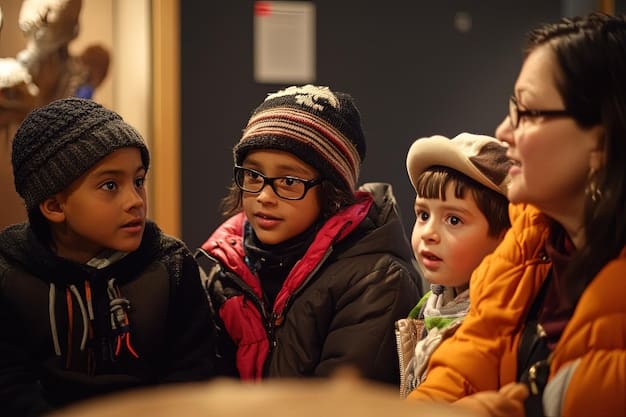Anime in US Schools: Exploring Educational Applications

Anime and education intersect in US schools through culturally relevant teaching methods, language learning, and promoting diverse storytelling to engage students.
In recent years, anime and education have found unexpected common ground in US schools. Educators are increasingly recognizing the potential of Japanese animation not only as a form of entertainment but also as a valuable tool for engaging students and enhancing the learning experience.
Anime’s Growing Presence in American Classrooms
Anime, a style of Japanese animation, has captivated audiences worldwide with its unique storytelling, diverse characters, and vibrant visuals. Its rising popularity has led to its integration into various aspects of American culture, and surprisingly, even into the education system. But how exactly are US schools using anime to teach students?
Cultural Relevance and Engagement
One of the primary ways anime is being incorporated into US schools is through culturally relevant teaching. Educators are using anime series that explore themes of friendship, perseverance, and social responsibility to connect with students on a deeper level. This approach acknowledges and values students’ diverse backgrounds and interests, making learning more meaningful and relatable.
Language Learning Opportunities
Anime also presents unique language learning opportunities. Many educators are using anime clips and series in Japanese language classes to enhance listening comprehension and vocabulary acquisition. Students are exposed to authentic language use, cultural nuances, and conversational styles, making the learning process more engaging and immersive.

Beyond language classes, anime can be a powerful tool for teaching cultural appreciation and understanding. Many anime series explore Japanese history, traditions, and social customs, providing students with insights into a different culture. This can foster empathy, respect, and a more global perspective.
Here are some of the key benefits of incorporating anime into the classroom that educators are observing:
- Increased student engagement and motivation
- Enhanced cultural awareness and understanding
- Improved language learning outcomes
- Development of critical thinking skills
In conclusion, anime’s growing presence in American classrooms is a testament to its versatility and potential as an educational tool. By tapping into students’ interests and providing culturally relevant content, educators are finding innovative ways to enhance learning and create a more engaging classroom environment.
Utilizing Anime for Curriculum Enrichment
Beyond its role in language and cultural studies, anime is being strategically used to enrich various areas of the curriculum in US schools. Educators are finding creative ways to integrate anime into subjects such as history, science, and literature, making learning more dynamic and engaging.
Historical and Social Contexts
Anime series often depict historical events, social issues, and cultural movements in Japan, offering students a unique perspective on these topics. For example, some educators are using anime adaptations of historical events to spark discussions about the causes and consequences of key moments in Japanese history. In addition, anime series that explore social issues can provide a platform for students to examine complex topics such as discrimination, poverty, and social inequality.
Scientific and Technological Concepts
Many anime series incorporate scientific and technological elements, providing opportunities for students to explore these concepts in a visually engaging manner. For example, some educators are using anime series that feature advanced technology to introduce students to concepts such as robotics, artificial intelligence, and space exploration. This can make learning more fun and accessible, and can spark students’ interest in STEM fields.

Anime adaptations of classic literature can also be used to engage students in literary analysis and critical thinking. By comparing and contrasting the original text with the anime adaptation, students can gain a deeper understanding of the themes, characters, and plot structures. This can also promote creativity and encourage students to think critically about the role of adaptation in shaping our understanding of stories.
Several strategies are being implemented to facilitate curriculum enrichment using anime:
- Selecting anime series that align with curriculum objectives
- Creating lesson plans and activities that integrate anime content
- Providing students with opportunities to discuss and analyze anime themes
- Encouraging students to create their own anime-inspired projects
In conclusion, the utilization of anime for curriculum enrichment is expanding in US schools, offering valuable learning experiences in various subjects. By carefully selecting appropriate series and integrating them into lesson plans, educators can enhance student engagement, promote critical thinking, and make learning more relevant and enjoyable.
Addressing Concerns and Criticisms
While the integration of anime into US schools offers numerous benefits, it’s important to acknowledge and address the concerns and criticisms that some educators and parents may have. It’s essential to have open and honest conversations about the potential challenges and to implement strategies to mitigate any negative impacts.
Content Appropriateness and Cultural Sensitivity
One common concern is the appropriateness of anime content for young audiences. Some anime series contain mature themes, violent scenes, or suggestive content that may not be suitable for all students. It’s crucial for educators to carefully screen anime series before using them in the classroom and to consider the age and maturity level of their students. Additionally, educators must be mindful of cultural sensitivities and avoid using anime series that may perpetuate stereotypes or promote harmful biases.
Educational Value and Misconceptions
Another criticism is that anime is simply entertainment and lacks educational value. Some argue that it’s a distraction from more traditional learning methods and that it may not be aligned with curriculum standards. However, many educators are demonstrating that anime can be a valuable tool for enhancing learning if used strategically and thoughtfully. It’s important to dispel misconceptions and highlight the potential benefits of anime as an educational resource.
Here are some strategies for addressing concerns and criticisms:
- Establishing clear guidelines for selecting and using anime content
- Providing professional development for educators on integrating anime into the curriculum
- Communicating with parents and community members about the benefits of anime
- Creating a supportive and inclusive classroom environment
Open and respectful discussions between educators, parents, and community members are essential for building trust and ensuring student success. Concerns about content appropriateness, cultural sensitivity, and educational value should be taken seriously, while the potential benefits of anime as an educational resource are clarified through transparent communication.
Ultimately, the goal is to ensure that anime is used responsibly and effectively to enhance learning, promote cultural understanding, and prepare students for success in a diverse and interconnected world. This involves navigating potential challenges with care while embracing the transformative possibilities of integrating anime into the education system thoughtfully.
Successful Implementation Strategies
For US schools looking to effectively integrate anime into their curricula, several key strategies can ensure success. These strategies involve thoughtful planning, careful selection of materials, and active engagement with students’ interests and learning styles.
Curriculum Integration
Successful implementation begins with integrating anime strategically into the curriculum. Rather than using anime as a mere add-on, educators can align specific anime episodes or series with existing learning objectives in subjects like history, language arts, and social studies. For example, a history class studying feudal Japan might use anime to visualize historical events and cultural contexts.
Age-Appropriate Selection
Another critical strategy is to carefully select anime content that is age-appropriate and aligns with educational goals. Not all anime is suitable for every age group, and educators should preview materials to ensure they are free from inappropriate content, stereotypes, or themes that could be harmful to students. Resources like Common Sense Media can provide guidance on age ratings and content reviews.
Student Engagement
Engaging students is key to successful anime integration. Educators can encourage students to share their favorite anime and articulate the themes and values they appreciate. Interactive activities like discussions, debates, and creative projects (e.g., drawing anime-inspired art or writing fan fiction) can further deepen student engagement and understanding. This can enhance their critical thinking skills and foster a sense of ownership over their learning.
Key strategies for a successful implementation of anime in schools include:
- Incorporating anime into curriculum
- Careful selection of age-appropriate anime
- Engaging students in subject matter
- Incorporate discussions and debates
By employing these strategies, US schools can effectively harness the power of anime to enhance learning outcomes and create a more engaging and culturally inclusive educational environment. This encourages active student participation and creates a dynamic learning environment.
Case Studies: Schools Leading the Way
Several US schools have already begun to successfully integrate anime into their curriculum and extracurricular activities. These case studies illustrate the diverse ways anime can be used to enhance learning and engage students.
Case Study 1: Language Immersion Program
One elementary school in California uses anime as a key component of its Japanese language immersion program. Students watch subtitled anime episodes to improve their listening comprehension, vocabulary, and cultural understanding. Classes often revolve around interactive anime-themed discussions, activities, and projects. This fosters a deep cultural appreciation, builds more comprehensive language skills, and enhances student engagement.
Case Study 2: After-School Anime Club
A middle school in New York has established a thriving anime club that meets weekly. Students watch and discuss popular anime series, organize cosplay events, and create fan art. The club has become a safe and inclusive space where students can bond over their shared interests, develop their creativity, and build social skills. The activities and discussions encourage inclusivity and collaboration.
These schools stand out because:
- They provide language immersion
- They have anime clubs that foster creativity
- They bond around shared interests
These examples demonstrate that anime integration can take many forms, but successful implementation requires thoughtful planning, careful selection of materials, and a commitment to creating a positive and inclusive learning environment. These schools serve as models for others looking to explore the potential of anime in education.
Future Trends and Possibilities
Looking ahead, the integration of anime into US schools has the potential to evolve in exciting and innovative ways. As technology advances and cultural awareness grows, we can anticipate several key trends shaping the future of anime in education.
Virtual Reality Integration
Virtual reality (VR) offers immersive learning experiences that can bring anime to life in new ways. Imagine students virtually stepping into the world of their favorite anime series to explore historical settings, interact with characters, and solve problems. VR has potential to create engaging, interactive learning experiences.
Artificial Intelligence
Artificial intelligence (AI) can personalize anime-based learning experiences by identifying students’ interests, learning styles, and knowledge levels. AI-powered platforms can recommend anime content tailored to individual needs, provide real-time feedback, and even generate interactive storylines that adapt to student choices.
Looking forward in education using anime:
- Virtual Reality (VR) can enhance learning
- Artificial Intelligence (AI) can personalize learning experiences
- Global collaboration with other institutions
The future of anime in education looks promising, with the potential to transform learning experiences, engage students, and promote cultural understanding. By embracing technology and fostering collaboration, US schools can harness the power of anime to prepare students for success in an increasingly globalized world.
| Key Point | Brief Description |
|---|---|
| 💡 Cultural Relevance | Anime connects with students through shared cultural themes and values. |
| 🗣️ Language Learning | Anime enhances language skills through authentic language exposure. |
| 📚 Curriculum Enrichment | Anime integrates into subjects like history, science, and literature. |
| 🤖 Future Trends | VR and AI offer immersive and personalized anime learning experiences. |
FAQ
▼
Anime engages students and provides culturally relevant ways to teach subjects and enhance their overall learning experience.
▼
It enhances language skills via visuals, exposure to context, and helps build comprehensive language skills.
▼
There are some inherent concerns about content appropriateness and misconceptions of the overall educational value.
▼
Anime has seen growing success in the language emersion schools and the popularity of anime clubs.
▼
Some potential new trends are virtual reality and artificial intelligence that enhance the overall learning experience.
Conclusion
In conclusion, the integration of anime into US schools represents a promising avenue for enhancing education. By leveraging its cultural relevance, language-learning potential, and diverse storytelling, educators engage students and make learning more dynamic. While challenges exist, careful planning and thoughtful implementation can unlock the full potential of anime as an educational tool, preparing students for success in a globalized world.






